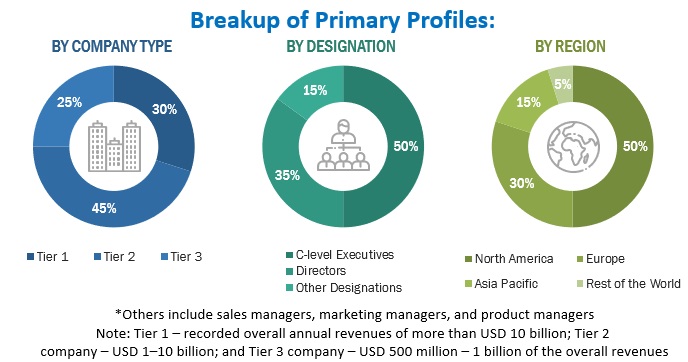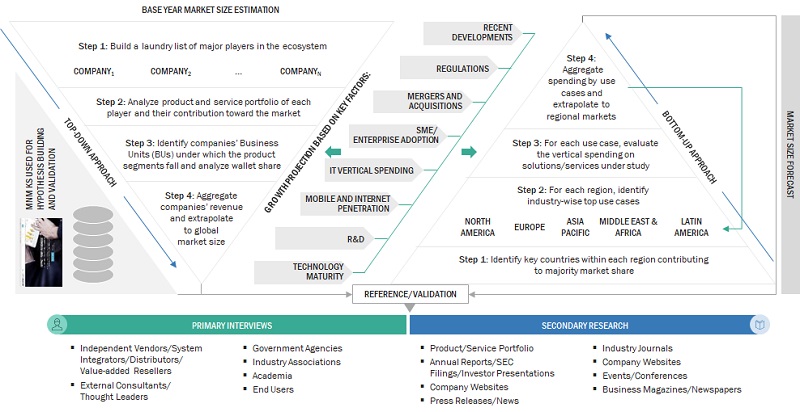The study involved four major activities in estimating the current chaos engineering tools market size. Extensive secondary research was done to collect information on the market, the competitive market, and the parent market. The next step was to validate these findings, assumptions, and sizing with industry experts across the value chain through primary research. Both top-down and bottom-up approaches were employed to estimate the complete market size. After that, the market breakup and data triangulation procedures were used to estimate the size of the various segments in the chaos engineering tools market.
Secondary Research
This research study used extensive secondary sources, directories, and databases, such as D&B Hoovers, DiscoverOrg, Factiva, vendor data sheets, product demos, Cloud Computing Association (CCA), Vendor Surveys, Asia Cloud Computing Association, and The Software Alliance. All these sources were referred to for identifying and collecting valuable information for this technical, market-oriented, and commercial study of the chaos engineering tools market.
Primary Research
Primary sources were several industry experts from the core and related industries, preferred software providers, hardware manufacturers, distributors, service providers, technology developers, alliances, and organizations related to all segments of the industry’s value chain. In-depth interviews were conducted with various primary respondents, including key industry participants, subject-matter experts, C-level executives of key market players, and industry consultants, to obtain and verify critical qualitative and quantitative information and assess the market’s prospects.
Primary interviews were conducted to gather insights, such as market statistics, the latest trends disrupting the market, new use cases implemented, data on revenue collected from products and services, market breakups, market size estimations, market forecasts, and data triangulation. Primary research also helped understand various technology trends, segmentation types, industry trends, and regions. Demand-side stakeholders, such as Chief Information Officers (CIOs), Chief Technology Officers (CTOs), and Chief Security Officers (CSOs); the installation teams of governments/end users using chaos engineering tools; and digital initiatives project teams, were interviewed to understand the buyer’s perspective on suppliers, products, service providers, and their current use of services, which would affect the overall chaos engineering tools market.

To know about the assumptions considered for the study, download the pdf brochure
Market Size Estimation
Both top-down and bottom-up approaches were used to estimate and forecast the chaos engineering tools market and other dependent submarkets. The bottom-up procedure was deployed to arrive at the overall market size using the revenues and offerings of key companies in the market. With data triangulation methods and validation through primary interviews, this study determined and confirmed the exact value of the overall parent market size. The overall market size was then used in the top-down procedure to estimate the size of other individual markets via percentage splits of the market segments.
The top-down and bottom-up approaches were used to estimate and validate the size of the chaos engineering tools market and various other dependent subsegments.
The research methodology used to estimate the market size included the following details:
-
The key players in the market were identified through secondary research, and their revenue contributions in the respective countries were determined through primary and secondary research.
-
This procedure included studying top market players' annual and financial reports and extensive interviews for key insights from industry leaders, such as Chief Executive Officers (CEOs), VPs, directors, and marketing executives.
-
All percentage splits and breakups were determined using secondary sources and verified through primary sources.
All the possible parameters that affect the market covered in this research study have been accounted for, viewed in extensive detail, verified through primary research, and analyzed to get the final quantitative and qualitative data. This data is consolidated and added with detailed inputs and analysis from MarketsandMarkets.
Chaos engineering tools market: Top-down and bottom-up approaches

To know about the assumptions considered for the study, Request for Free Sample Report
Data Triangulation
After arriving at the overall market size, the market was split into several segments and subsegments—using the market size estimation processes as explained above. To complete the overall market engineering process and arrive at the exact statistics of each market segment and subsegment, data triangulation and market breakup procedures were employed, wherever applicable. The data was triangulated by studying several factors and trends from both the demand and supply sides in the chaos engineering tools market.
Market Definition
Chaos engineering tools are software applications and platforms designed to facilitate the practice of chaos engineering. Chaos engineering is a discipline that involves controlled, deliberate experiments on a system or application to identify weaknesses, vulnerabilities, and potential points of failure. The goal is to proactively improve the system's resilience, fault tolerance, and reliability. These tools typically provide the means to inject various forms of controlled chaos into a system, enabling engineers to simulate real-world scenarios and observe how the system responds under stress. The observations from these experiments help teams uncover vulnerabilities and shortcomings in their architecture, enabling them to make targeted improvements.
Key Stakeholders
-
IT Service Providers
-
Support Infrastructure Equipment Providers
-
Component Providers
-
Software Providers
-
System Integrators
-
Network Service Providers
-
Consulting Service Providers
-
Professional Service Providers
-
Distributors and Resellers
-
Cloud Providers
-
Colocation Providers
-
Enterprises
-
Government and Standardization Bodies
-
Telecom Operators
-
Healthcare Organizations
-
Financial Organizations
-
Datacenter Vendors
-
Technology partners
-
Technology providers
Report Objectives
-
To define, describe, and forecast the global chaos engineering tools market based on component, application, deployment, end user, vertical, and region
-
To forecast the market size of the five major regional segments: North America, Europe, Asia Pacific, Middle East & Africa, and Latin America
-
To strategically analyze the market subsegments with respect to individual growth trends, prospects, and contributions to the total market
-
To provide detailed information related to the major factors influencing the growth of the market (drivers, restraints, opportunities, and challenges)
-
To strategically analyze the macro and micromarkets1 with respect to growth trends, prospects, and their contributions to the overall market
-
To analyze the industry trends, patents and innovations, and pricing data related to the chaos engineering tools market.
-
To analyze the opportunities in the market for stakeholders and provide details of the competitive landscape for major players.
-
To profile the key players in the market and comprehensively analyze their market share/ranking and core competencies across segments and subsegments.
-
To track and analyze the competitive developments, such as mergers and acquisitions, product developments, and partnerships and collaborations in the market.
Available Customizations
With the given market data, MarketsandMarkets offers customizations as per the company’s specific needs. The following customization options are available for the report:
Product Analysis
-
The product matrix provides a detailed comparison of the product portfolio of each company.
Geographic Analysis
-
Further breakup of the Asia Pacific market into countries contributing 75% to the regional market size
-
Further breakup of the North American market into countries contributing 75% to the regional market size
-
Further breakup of the Latin American market into countries contributing 75% to the regional market size
-
Further breakup of the Middle Eastern & African market into countries contributing 75% to the regional market size
-
Further breakup of the European market into countries contributing 75% to the regional market size
Company Information
-
Detailed analysis and profiling of additional market players (up to 5)



Growth opportunities and latent adjacency in Chaos Engineering Tools Market